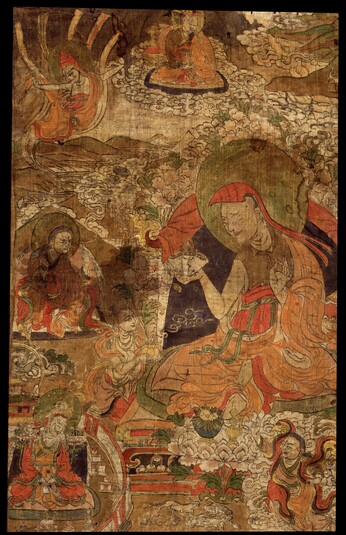
Item: Padmasambhava - 8 Forms: Pema Jungne
| Origin Location | Eastern Tibet |
|---|---|
| Date Range | 1800 - 1899 |
| Lineages | Nyingma |
| Size | 53.98x33.66cm (21.25x13.25in) |
| Material | Ground Mineral Pigment on Cotton |
| Collection | Tibet House, New York |
Classification: Deity
Appearance: Monastic
Gender: Male
Pema Jungne (English: the Lotus Born): #4 from the set of Eight Manifestations of Padmasambhava.

In the appearance of a monk with the right hand he holds upraised a skullcup filled with nectar and performs the mudra of explication with the left. Wearing the patched orange robes of a fully ordained monk and a red pandita hat he is seated in a relaxed posture with the right leg forward and the left drawn up atop a cushioned seat and ornate throne with a fabric covered backrest. The princess Mandarava stands at the side holding a golden vase requesting Dharma teachings. At the front a begging bowl and water flask are placed on a table formed of a lotus blossom and stem.
At the top center is the guru Dhanasamskrita with the two hands folded in the lap holding a long-life vase; dressed as a layman. To Padmasambhava he taught the system of Matarah (Tib.: ma mo bo tong) from the 8 Heruka Sadhanas. To the left is Nanam Yeshe De, dressed as a monk and wearing a red pandita hat; flying in the air. Below is Nub Sanggye Yeshe with the right hand performing the mudra of explication and the left upraised; with long hair, attired in the garments of a layman. At the bottom left is the King Trisong Detsen with the two hands placed in the lap while holding the stems of two utpala flowers supporting a wisdom sword and book. He is seated within the courtyard of the temple of Chokor Samye Ling. These last three are from the famous set of 25 main students of Guru Rinpoche. At the lower right is a lay devotee.
Due to a misunderstanding the King of Zahor tried to burn Guru Rinpoche alive and through magical transformation the fire-pit was changed into a lake and Guru Rinpoche appeared as an 8 year old youth above a lotus blossom with multiple attendants all in the appearance of the princess Mandarava. At this time the now reverential King bestowed the name 'Padmasambhava.' The drawing of the painting is based on a set of Derge xylograph prints from Kham, Tibet, 19th century.
Jeff Watt 10-98
Collection of Tibet House: New York (Repatriation)
Padmasambhava: Eight Forms Main Page
Padmasambhava: Pema Jungne
Collection of Tibet House, NY (Teachers)
